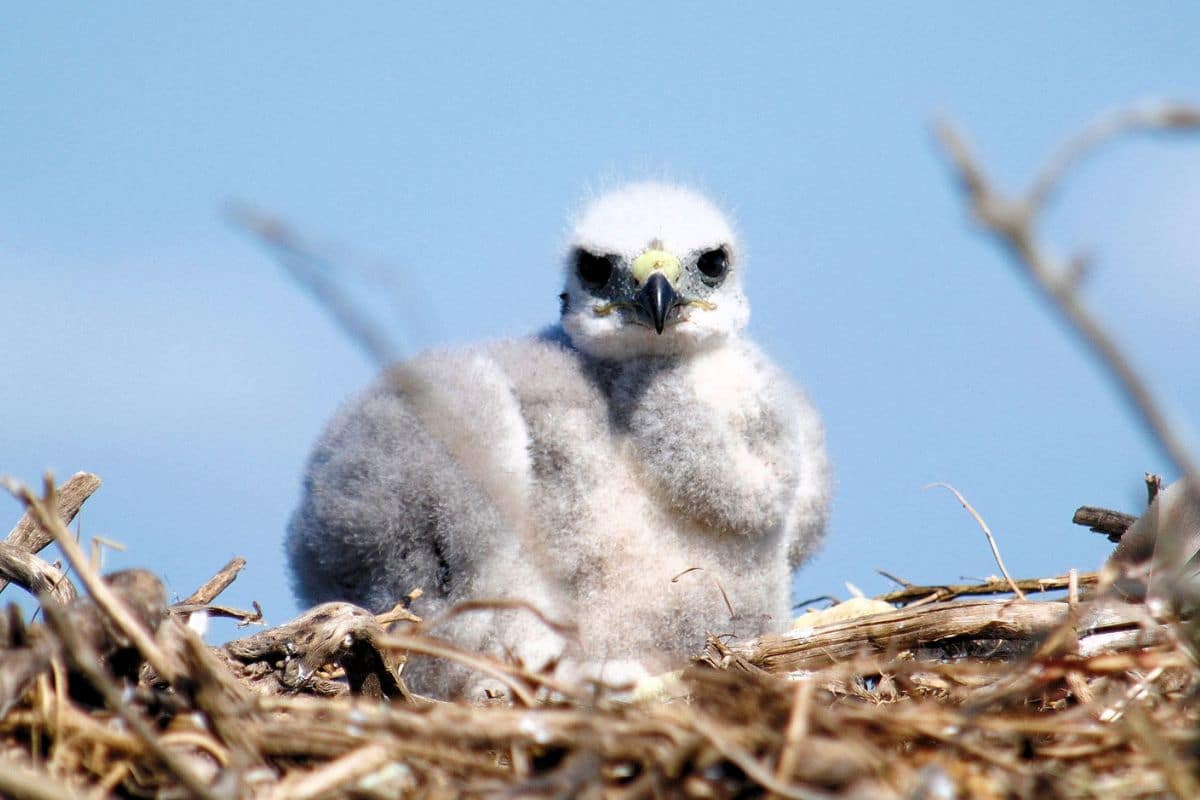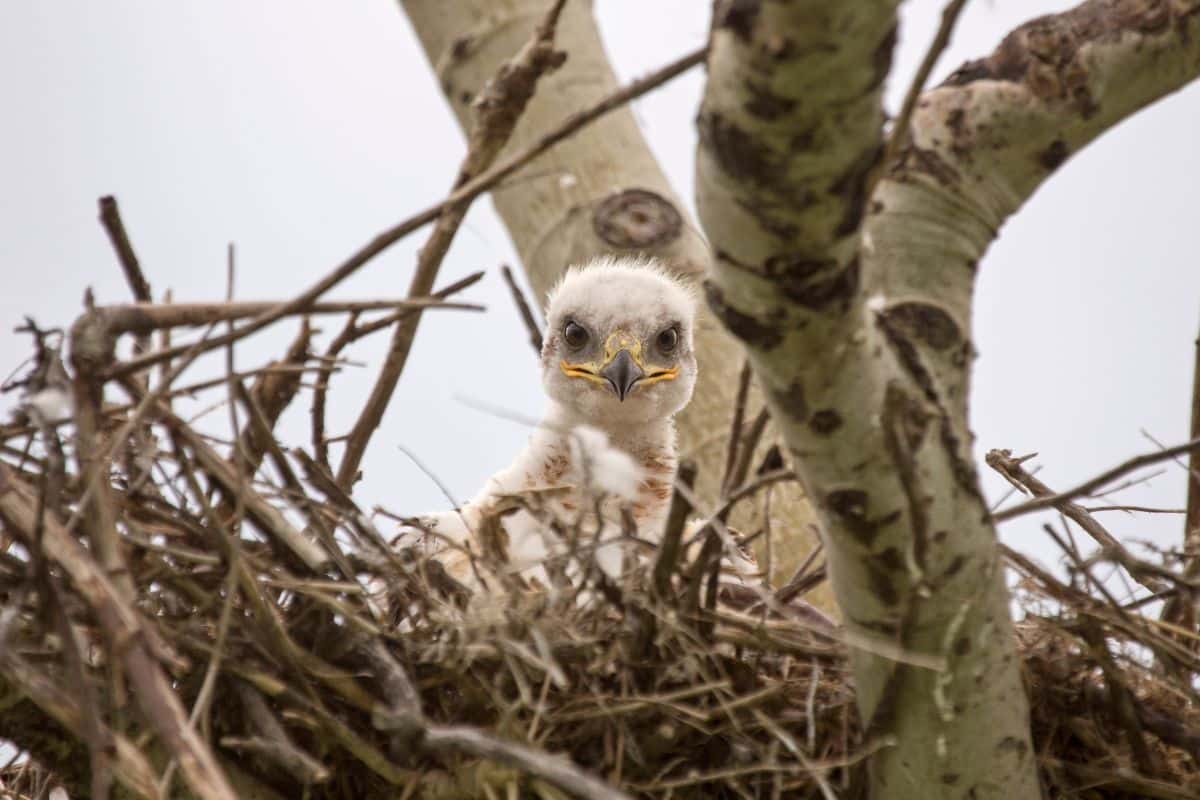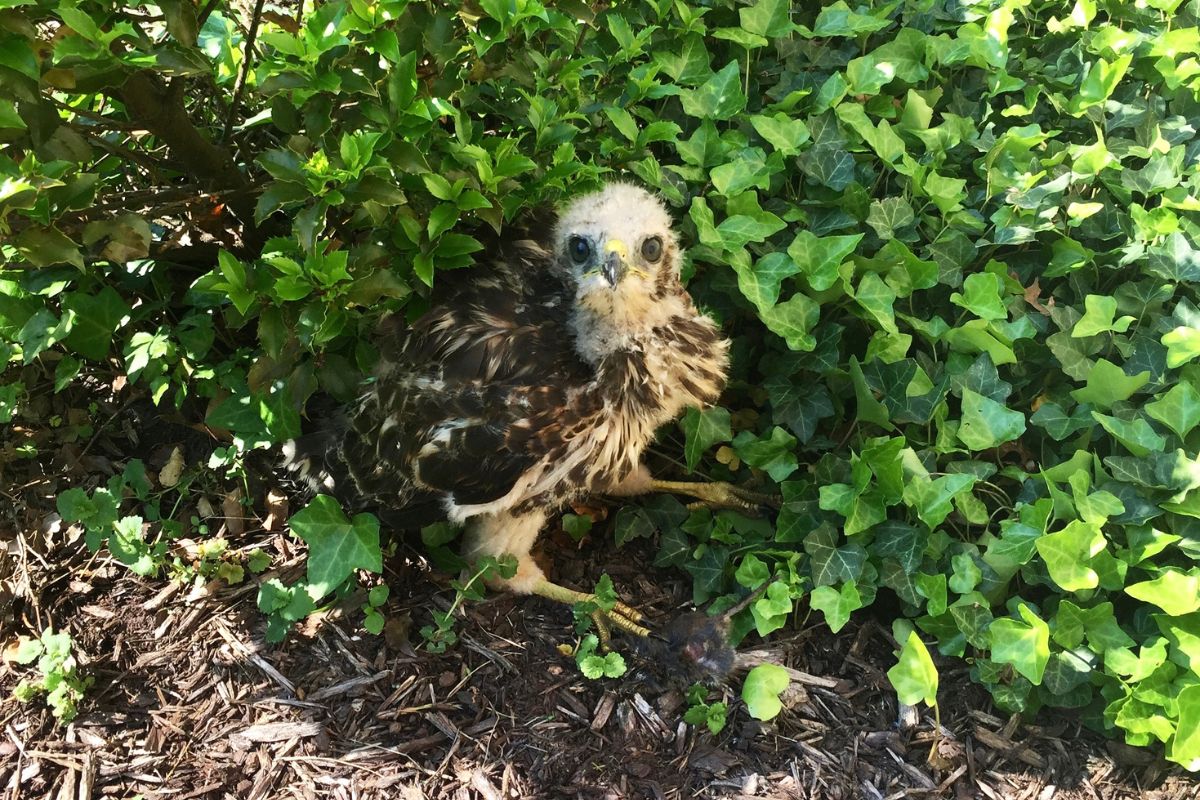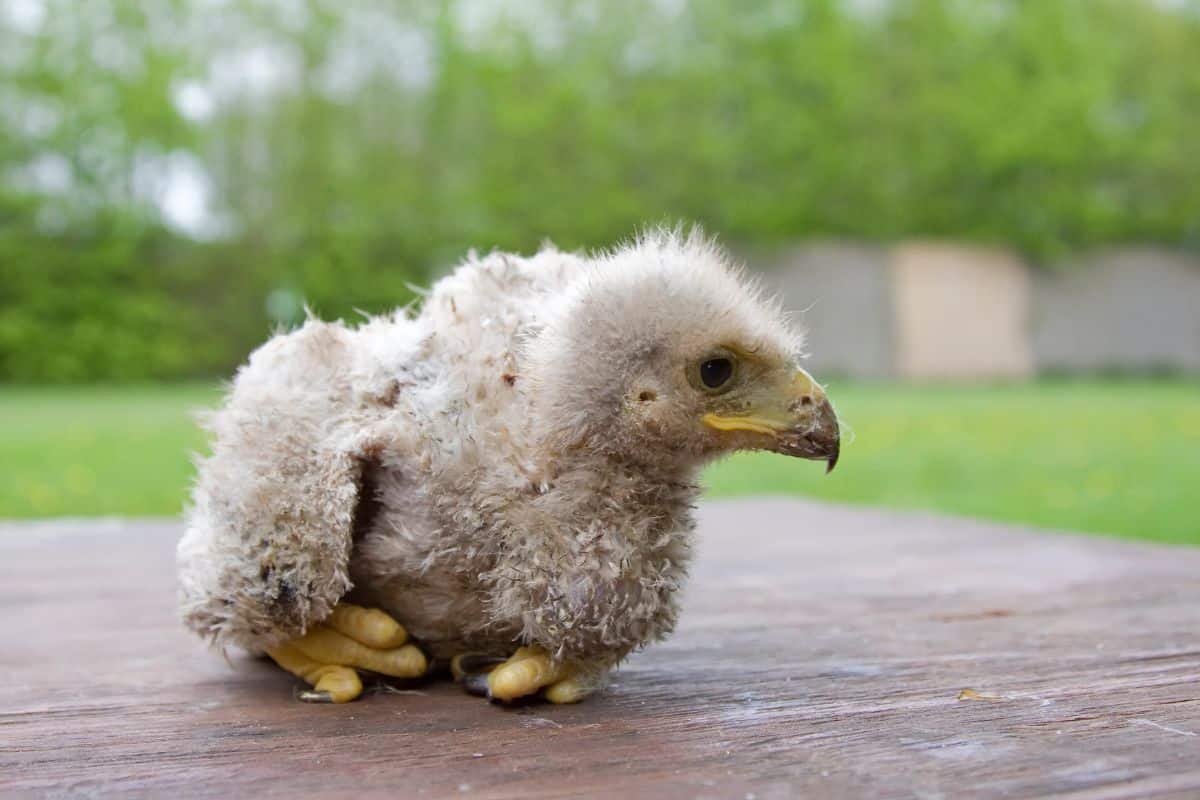Hawks are fierce predators that are found almost all over the world. They can be amazing to watch, but their young are rarely seen. Baby hawks are hard to spot because their nests are usually so high up to keep them protected.

Since it may be hard for you to observe and learn about a baby hawk by yourself, we’ve created a complete guide with all the information for you.
Contents
What Are Baby Hawks Called?
Baby hawks are called eyas when they’re first born and before they can fly. This term is also used for any baby falcon. Other names people generally have for them are hawklets, hatchlings, or even chicks.
When they’re first born, they are relatively small, covered in a fluffy natal down, and utterly dependent on their parents. Once they get their juvenile flight feathers and fledge or take their first flight, they’re called fledglings.
All About Hawk Nests
An eyrie is the name of a nest of any bird of prey that’s usually found up on cliffs or high in the trees. This definition fits the hawk nest completely.
A pair of hawks will work on building their nests together out of small to medium-sized sticks and other materials, but it’s generally the female that cushions the inside of the nest with softer materials like pine needles or corn husks to add extra padding for their young.
Hawks usually begin building their nests about a month or two before they are due to lay their eggs. They generally will begin a nest sooner if they’re starting from scratching instead of reusing an old one.
Depending on the specific species, hawks will either find an old crow’s or squirrel’s nest to remodel and use, or they may build their own. Their nests are usually located deep in the woods or forests, high up in the trees where they won’t be disturbed.
They don’t care so much about the type of tree they nest in; they seem to be more concerned with how tall and wide the tree is and its location. If trees are scarce, they may choose to nest on a cliff or transmission poles, anywhere that is high up. Some hawks prefer to be up as high as 90-100 feet. Due to their desire to nest extremely high up, they’re usually hard to see without a set of binoculars.

The time of year hawks lays their eggs will ultimately depend on the breed and the area they are located. Generally speaking, hawks primarily lay their eggs in the spring, but some will lay eggs as late as summer time or even late winter.
Depending on the hawk type, they can lay between 1-5 eggs in a clutch. The larger the species of hawk, the fewer eggs they will lay. Sometimes, if the eggs don’t make it, they may produce a second clutch.
Hawk eggs are whitish with brown splotches on them, and the parents need to incubate them for roughly 28-35 days. It can take up to 12 hours for a baby hawk to break free from its shell.
They have no real flight feathers when first born but are covered in a fluffy down. Depending on the hawk type, the eyasses can be white, brown, gray, or a mix of all three. The species of a hawk will also determine its size.
Generally, they’re only a few inches long, but the weight and height vary based on the type of hawk. For example, the smaller, red-tail hawks are generally about two ounces when they’re first born, while the larger, broad-winged hawks can be about seven ounces.
Shortly after they’re first born, they make little peeping sounds to keep in contact with their parents. As they grow, they begin making squealing or whistling sounds, closer resembling the shrieking sounds of the parents. These squealing sounds usually can start when they’re around ten days old.
What Do Baby Hawks Eat?
They generally prefer to eat small mammals, rodents, lizards, insects, and even birds. The diet remains the same even for their young, which can require food 10-15 times a day.
Generally, the father hawk will do most of the hunting while the mother cares for the young. Baby eyasses are not born with sharp beaks or talons, so in the beginning, the parents will rip the prey they catch into strips for the first four or five weeks of the baby’s life. As the babies grow, the parents will give whole carcasses for the babies to rip up the meat themselves.
After they fledge, the parents teach them to hunt for food. However, the parents generally continue to provide food for another 4-7 weeks after they first leave their nest. Eventually, the parents stop feeding them to encourage them to hunt for themselves.
When Do Baby Hawks Leave the Nest?

They stop being the little fluffy fuzz balls and begin to grow their flight feathers around three weeks. They will start to hop around and flap their little wings to practice, but it will take a while, about a month and a half, before they begin to spread their wings and fly. In general, the smaller-sized males tend to mature faster than the larger-sized females. It’s also more common for western hawks to fledge before hawks native to the eastern region.
After they fledge, they will gradually take further and longer flights to strengthen their wings. It takes a good two weeks of flying to get their wings strong enough for a good flight, where they will start to help their parents hunt for prey. It usually takes a few weeks before they begin to catch their prey, but they pick it up rather quickly after their first successful hunt.
Depending on the species of hawk, the babies can stay with their parents for up to six months after fledging. They remain in their parents’ territory, approximately two square miles, for 30-70 days after leaving the nest before migrating to a domain they can choose as home.
What Is the Survival Rate of Baby Hawks?
A hawk’s survival rate is relatively high in the early stages of life. There is approximately a 70% chance that a baby will survive before fledging. However, after that, the survival rates begin to decline. Within the first year, about 50% of them will pass away. Only a few will survive beyond ten years out of a thousand hawks.
Although they have a decent chance of survival in the early years of life, a few things can contribute to the loss of life for a baby hawk. The babies are susceptible to malnutrition and predators.
Malnutrition is one of the main things that can harm a baby hawk. Although they grow fast, in some cases, it may not be fast enough since they are so dependent on their parents.
In some circumstances, they may just be randomly abandoned, although this doesn’t happen often. Usually, when a baby is left to fend for itself and ultimately starves, it’s because something happened to the parents. They may have been killed by a person or a predator or died under other circumstances. The different situations that cause malnutrition are also outside of the parent’s control.
Malnutrition can be caused solely by a lack of food availability. If the parents are struggling with hunting, they won’t be able to find enough food needed for everyone to survive. In other instances, the parents may catch food that’s been poisoned. The poisoning usually occurs unintentionally when a person tries to get rid of mice or other food for the hawks.
The other potential risk is natural predators. Baby hawks are susceptible to being eaten by birds of prey, including other hawks known for hunting on other hawks’ nests. Even as eggs, they’re not safe and can be stolen and eaten by scavengers such as raccoons or even snakes.
What Should You Do if You Find a Baby Hawk?

If you find a baby hawk, do not feed it bread or milk or anything that is not meat. Young eyas cannot survive without their parents and will need the help of a licensed rehabilitator. It is federally illegal to keep a wild animal such as a hawk, so it’s essential to seek proper care for the animal.
Try to keep the hawk warm while you contact animal control and see what they recommend is the best course of action.
Final Thoughts
Eyas is a name for an adorable baby hawk that is fed by its parents even after it has fledged and left the nest. The babies start as small balls of fluff and quickly grow into their juvenile flying feathers, allowing them to become fierce predators like their parents.
Although they are fragile when they’re babies, it is important not to mess with them if you’ve found one abandoned. Contact animal control or a licensed rehabilitator to care for the hawklet properly.
